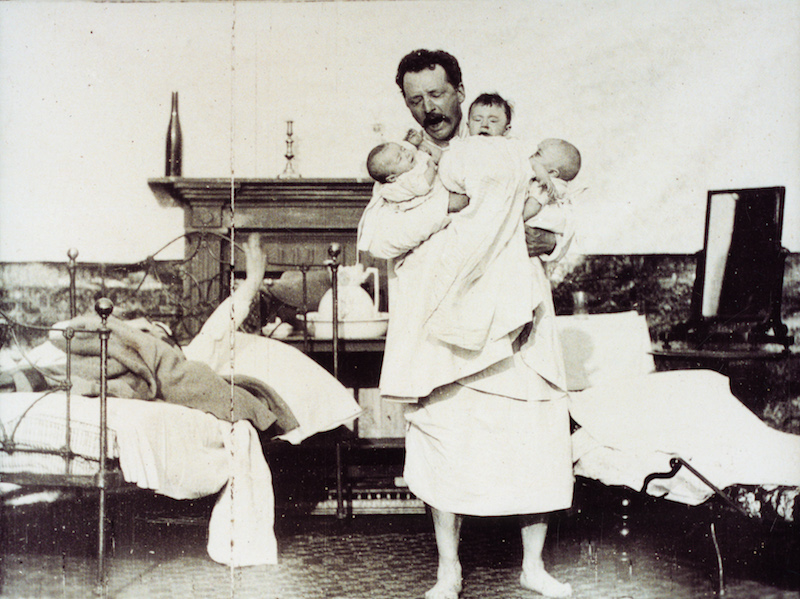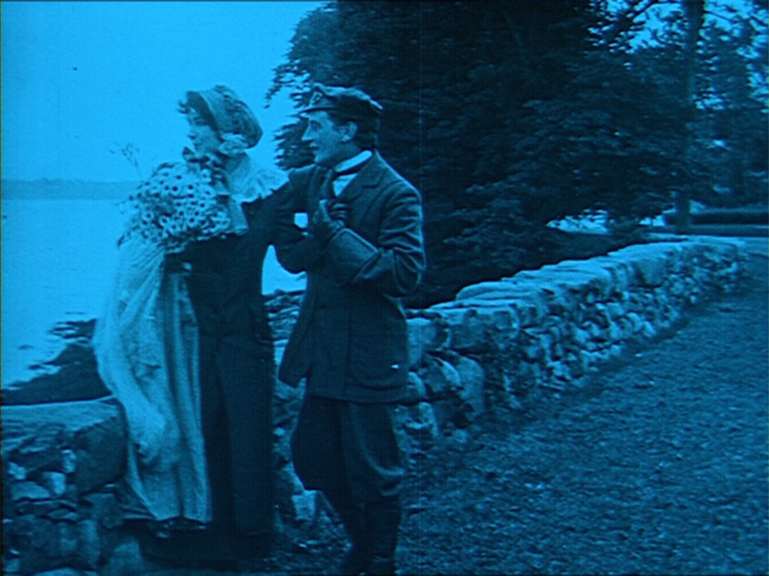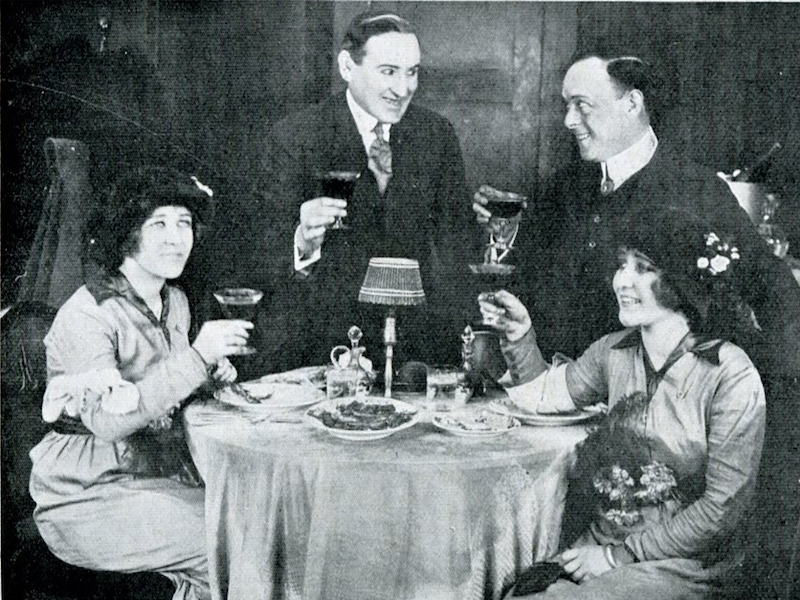DESMET COLLECTION 2019
curated by Elif Rongen-Kaynakçi
Twins
As always with the Giornate’s Desmet programs, the films of this year’s chosen theme approach its subject from different angles, and we’ve been less than rigid in what we’ve allowed to be categorized under this heading. In the case of “Twins,” mistaken identity is a crucial element in both the comedies and dramas. One film employs a single actress to play both siblings in a dual role, Lois Weber in The Twins; but in the case of Mixed Identities, real twins Alice and Edna Nash were cast. We’ve also included a ravishing dance film featuring the Guy Sisters (Edmonde, Christiane, and Marie), none of whom were twins though they were often styled to look the same, perhaps influenced by the famed Dolly Sisters, with whom they shared a stage in 1923 at the Café des Ambassadeurs in Paris.
WHY PAPA CAN’T SLEEP (US 1896? GB 1898?)
regia/dir: William K. L. Dickson?. photog: William K.L. Dickson?, asst. Emile Lauste?. cast: ?. prod: American Mutoscope Co.? uscita/rel: 12.1896 (orig. vers.). copia/copy: 35mm, 63 ft., 53″ (18 fps); senza did./no titles. fonte/source: EYE Filmmuseum, Amsterdam.
A harried father reluctantly looks after triplets as his irate wife goes back to sleep. According to Paul Spehr in The Man Who Made Movies: W.K.L. Dickson (2008), the director and his young camera assistant Emile Lauste filmed this in New Haven, Connecticut, using theatrical props for the first time in an American Mutoscope comedy. However, as only one baby’s presence is mentioned in the 1896 US version in the copyright records, the presence of 3 children in this version raises some doubts as to whether this could instead be an 1898 remake by the British branch of Mutoscope. The EYE copy is duplicated from an original 68mm print held in the archive.
Elif Rongen-Kaynakçi
As for the 1896 version, Why Papa Can’t Sleep … was almost certainly made at the recommendation of S.Z. Poli, the owner/manager of Poli’s Wonderland Theater in New Haven. Biograph’s 68mm projector … succeeded Lumiere’s Cinematograph at Poli’s in November 1896 and remained on the bill there until well after 1900. … Poli apparently asked American Mutoscope Co. to do some filming in New Haven so his audience could see themselves on screen. Dickson came in November and made several films, including the Yale football team at scrimmage. The December trip was the second, and the first with Emile Lauste … [who] almost certainly operated the camera.
It was close to Christmas when they were in New Haven and Emile Lauste’s memories are of filming several snow scenes in cold weather. But they made two comedy films, Why Papa Can’t Sleep and The Prodigal’s Return, 3 A.M. There is no information on where these were filmed, but presumably it was outdoors near the theater. Exposing the film at 30 fps required a lot of light so films were shot outdoors during midday with the sun lighting the full scene. Tradition has it these were made in the alley behind the theater but I’ve seen nothing confirming that. However, props, costumes, and, in all probability the performers came off the stage. So these were almost certainly comedy skits from the program at Poli’s Wonderland. … [T]he performers remain unidentified. These were the first comedies that American Mutoscope filmed.
Paul Spehr (e-mail to Jay Weissberg, 14.09.19)
MIXED IDENTITIES (US 1913)
regia/dir: William Humphrey. scen: Eliza G. [Graham] Harral. cast: Wally Van (Lothario Redman [Mr. Redmond]), Alice Nash (Alice), Edna Nash (Edna), William Humphrey (Sparkins Carter [Mr. Freddy]), Rose Tapley (la madre dei gemelli/the twins’ mother). prod: Vitagraph. uscita/rel: 21.04.1913. copia/copy: 35mm, 700 ft. (orig. 700 ft.), 9’55” (18 fps); did./titles: NLD. fonte/source: EYE Filmmuseum, Amsterdam (Desmet Collection).
A mixed-identity comedy that seems to have been the stock-in-trade of identical twins Alice and Edna Nash, who worked exclusively for Vitagraph. Here they play stenographers whose flirtatious bosses are friends; each man invites his employee to a restaurant, where accusations lead to jollity when they’re unable to distinguish one twin from the other. According to contemporary press reports, even people at the studio were unable to tell the Nash sisters apart; the pair fell into obscurity following an appearance in Charles Dillingham’s 1920 stage extravaganza Good Times, in which they appeared with several other sister acts.
Little is known of writer Eliza Graham Harral (1872-1938), who is credited with a number of Vitagraph titles made in 1913. On the other hand, director and actor William Humphrey (1875-1942) was busy on both sides of the camera for decades, though after 1920 he appears to have given up directing and remained an actor until shortly before his death. Mixed Identities was released on a split reel with Gala Day Parade, Yokahama, Japan.
Elif Rongen-Kaynakçi
THE TWINS (US 1911)
regia/dir: Lois Weber, Phillips Smalley?, Edwin S. Porter?. scen: Lois Weber?. cast: Lois Weber (Miss Golden, la gemella ricca/the wealthy twin; Lucy Norton, the seamstress twin), Phillips Smalley (Jack Golden), Joe Engel (Richard Golden, wealthy shirtwaist manufacturer), Miss Hohlfeld (stenographer). prod: Edwin S. Porter, Rex. uscita/rel: 15.06.1911. copia/copy: DCP, 15′, col. (da/from 35mm, 299 m./981 ft., imbibito/tinted); did./titles: ENG. fonte/source: EYE Filmmuseum, Amsterdam (Desmet Collection).
Recently rediscovered by Elif Rongen-Kaynakçi in the Desmet Collection at EYE, Twins (sometimes called The Twins) is one of the oldest surviving prints from Lois Weber’s early work at Rex. Weber plays twin sisters separated at birth. One is adopted into a family of wealth and privilege where she is “pampered by money,” as one contemporary observer put it. The other is adopted by a widowed seamstress and endures “a life of toil and want.” Even as their parallel stories emphasize class inequity, the two women are aligned in their defiance of patriarchal authority, each initially unaware of the other. The wealthy sister rejects class privilege – and the pressure to marry her adoptive brother – in favor of a forbidden liaison with the family chauffeur. Her twin becomes the chief labor organizer at a shirtwaist factory owned by her wealthy sister’s father. When she attends a meeting to press for better working conditions, complications ensue.
“We worked very, very hard,” Weber later recalled of the time she spent at Rex. She and her husband Phillips Smalley joined the company in the autumn of 1910 shortly after it was founded by Edwin S. Porter, beginning work on the company’s first release, A Heroine of ’76. Initially credited only as actors, later accounts make it clear that the pair also co-directed most of their films from scripts penned by Weber, releasing one film per week at the height of their productivity. Weber’s storytelling skills are on display, even in an early film like Twins, as are her commitment to social justice and her interest in unconventional women who become agents of change in their own lives or the lives of others. Along with a deft use of cross-cutting to emphasize the twins’ “different stations in life,” the film includes elegantly composed shots where action is staged across multiple planes in order to emphasize glances exchanged between characters but unseen by others. These are all hallmarks of films that Weber would direct over the course of her three-decade career. Twins provides a fascinating glimpse of their beginnings.
Shelley Stamp
HELLO SAILOR (Nog Zoo’n Zeeman – En De Vloot Vergaat!!) (US 1927)
regia/dir: Mark Sandrich. photog: Jay Turner. cast: Lupino Lane, Wallace Lupino, Charlene Aber, Minniela Aber, Petey the dog. prod: E.W. Hammons, Lupino Lane Comedies, Educational Pictures. dist: Educational Film Exchange. uscita/rel: 25.12.1927. copia/copy: 35mm, 1463 ft. (2 rl.), 21’48” (18 fps); did./titles: NLD. fonte/source: EYE Filmmuseum, Amsterdam.
A couple of sailors – played by brothers Lupino Lane and Wallace Lupino – don’t know that the love letters they’ve been receiving are written by twins, leading to expected mirthful situations in this well-received slapstick showcase for British comedian Lane, who’d been making films in the U.S. since 1921 (two of his British comedies are included in Program 2 of the “Origins of European Slapstick” section). The twins here are Charlene (sometimes Charline) and Minniela (sometimes Arline) Aber, a couple of singing, dancing and violin-playing sisters who’d begun in vaudeville before making a few film appearances; shortly after, as the Aber Twins, the two continued on stage until the mid-1930s, including forming part of the cast of Broadway’s star-studded musical Smiles (1930), which featured Marilyn Miller and Fred and Adele Astaire. The Astaire connection is even stronger with director Mark Sandrich, who began his directorial career with Fox in 1926 but is of course known for some of the classic Fred Astaire-Ginger Rogers musicals like The Gay Divorcee and Top Hat. Regarding Hello Sailor, the Film Daily (11.12.1927) declared, “Can’t go wrong on this one.”
Elif Rongen-Kaynakçi, Jay Weissberg
[PARIJSCHE REVUE ATTRACTIES NO. 1] [Parisian Revue Attractions No. 1] (FR 1926)
regia/dir: ?. photog: ?. cast: Edmonde Guy, [Ernst (Ernest/Edmond)] Van Duren, Christiane Guy, Marie Guy, Hasoutra. prod: Alex Nalpas, Les Films A.N.C. uscita/rel: ?. copia/copy: 35mm, 231 m., 11′ (18 fps); did./titles: NLD. fonte/source: EYE Filmmuseum, Amsterdam.
At the moment we’re unable to identify the original title for the film catalogued under its Dutch release, Parijsche Revue Attracties, but at the end of December 1925 the French press were announcing the imminent appearance of a series made by Alex Nalpas’ Les Films A.N.C. featuring dance stars popular in Paris at the time. The first of the group would contain four numbers, of which only three have survived: Edmonde Guy and Van Duren in “Danse du Faune,” performed at the Moulin Rouge; the Sisters Guy from the Folies Bergère dancing to the Gene Buck and Dave Stamper song “That Broadway Indian of Mine”; and Mlle. Hasoutra from the New Monico in her famed “Danse du Serpent,” set to “Danse Indienne” by L. Hiller (though the composer was more likely Ferdinand Hiller). The intertitles contain several errors: the Sisters Guy were at the Palace, not the Folies Bergère, and Hasoutra was at the Casino de Paris at this time, not the New Monico. Missing from our print is a dance number featuring Tamara Gamsakourdia and Alexandre Demidoff in a Futurist setting.
Today Edmonde Guy (née Eugénie Goubé in 1903) is largely remembered as a muse of the painter Kees van Dongen and for her role as Princess Mandane in the film of the same title by Germaine Dulac, but she was a dance sensation whose escapades were chronicled by newspapers worldwide. She seems to have first partnered on stage with Ernst (sometimes Ernest or Edmond) Van Duren in 1921, and the pair became a great attraction in Europe as well as the U.S., where Florenz Ziegfeld hired them for Palm Beach Nights, 1926. Usually credited simply as Van Duren – Dutch newspapers claimed he was a Hungarian of Dutch descent – the dancer’s ephebic beauty was frequently remarked upon, and certainly an unmistakable effeminacy is evident in the dance seen here. On screen, he and Edmonde appeared together in A.W. Sandberg’s Klovnen as well as the Dulac film, but in 1930 he committed suicide. Lurid reports at the time claimed he was depressed over the end of a romantic attachment with Edmonde, though it’s far more likely he was in a relationship with the American dancer Jack Forrester, who found the body. Guy came from a performing family: in addition to her sisters Christiane and Marie, seen here dancing to a song written for the Ziegfeld Follies of 1923, there was also their younger brother Paul (1912-1979), who became a noted choreographer and founder of a dance school under his real surname Goubé. According to Ciné-Journal (14.04.1923), the Guy sisters and Van Duren were to be filmed by Stéphane Passet using César Parolini’s experimental 3-D process, but it’s uncertain whether this was ever made. Christiane and Marie were performing with their brother at least as late as 1937, and Edmonde last appeared at the Folies Bergère in 1944. The sisters’ death dates remain unknown.
The final number features the American dancer Hasoutra (sometimes Hassoutra), born Ryllis Barnes (1898-1978). A specialist in dances from India and the Far East, she traveled extensively in Asia, bringing her sensuous performances to Broadway and vaudeville beginning in the early 1920s and shortly after making a splash in Paris and London. One of her Orientalist dances was included in the Robertson-Cole short Starland Revue, No. 1 (1922), and she was also seen with the legendary clown Grock in Son premier film (1926; screening at this year’s Giornate in Program 5 of the European Slapstick section). According to her obituary in the New York Times, Hasoutra made four world tours between 1920 and 1950 with her own entertainment company before joining the U.S. State Department, where she worked as a foreign-service officer until 1972.
Elif Rongen-Kaynakçi, Jay Weissberg










